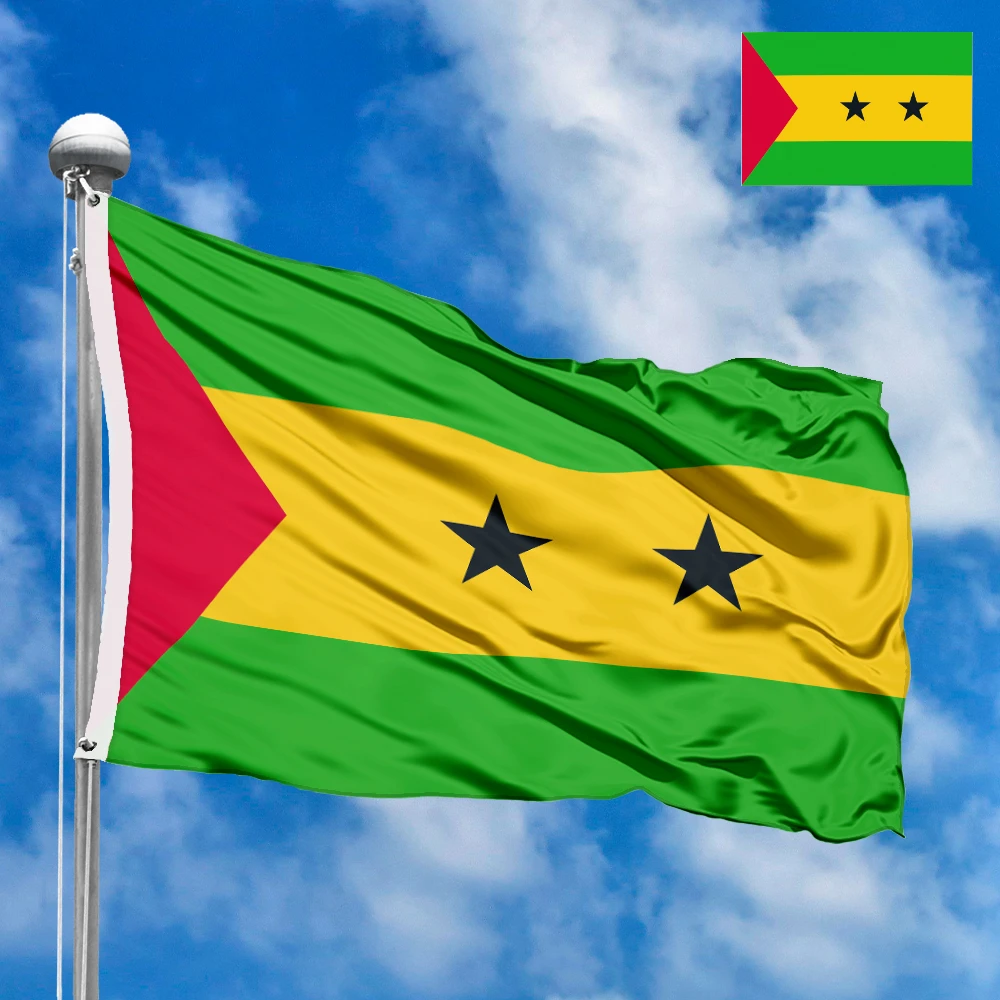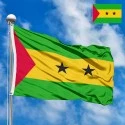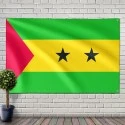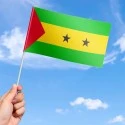The national flag of the Democratic Republic of São Tomé and Príncipe is a vibrant and symbolically rich emblem that encapsulates the nation's journey towards independence, its deep connection to the African continent, and its aspirations for a prosperous and united future. Adopted on November 5, 1975, shortly after gaining independence from Portugal, the flag is a powerful visual representation of the values and identity of this small island nation in the Gulf of Guinea. Its design elements are carefully chosen to reflect the country's unique geographical position, its natural wealth, and the determination of its people.
Design and Symbolism: A Tapestry of African Unity and Island Identity
The flag of São Tomé and Príncipe features three horizontal stripes of green, yellow, and green, with a red triangle positioned at the hoist (left) side. Two black stars are centrally placed on the yellow stripe. Each color and element carries profound symbolic meaning:
-
Green Stripes (Top and Bottom): The two green horizontal stripes represent the lush vegetation, rich agricultural resources, and abundant forests of the islands of São Tomé and Príncipe. They symbolize the nation's natural wealth, particularly its cocoa and coffee plantations, which have historically been the backbone of its economy. Green also signifies hope for the future and the nation's commitment to sustainable development and environmental preservation.
-
Yellow Stripe (Central): The broad central yellow horizontal stripe symbolizes peace and the sun that shines brightly over the islands. Yellow also represents the agricultural bounty and the rich natural resources of the nation, emphasizing the importance of its fertile lands and the prosperity they bring. It reflects the warmth and hospitality of the people of São Tomé and Príncipe.
-
Red Triangle (Hoist Side): The red triangle positioned at the hoist side of the flag signifies the hard-won struggle for independence and the blood shed by the people in their fight against colonial rule. It represents the courage, sacrifice, and determination of those who fought for the nation's freedom and sovereignty. Red is a powerful reminder of the nation's revolutionary past and its commitment to self-determination.
-
Black Stars (on Yellow Stripe): Two black five-pointed stars are centrally placed on the yellow stripe. These stars represent the two main islands that constitute the nation: São Tomé and Príncipe. The black color of the stars symbolizes the African heritage of the people of São Tomé and Príncipe, emphasizing their historical and cultural ties to the broader African continent. Their placement on the yellow stripe signifies the unity and solidarity between the two islands and their shared destiny.
The overall design, particularly the combination of Pan-African colors (red, yellow, green) and the black stars, firmly positions São Tomé and Príncipe within the broader African family of nations, while simultaneously highlighting its unique dual-island identity.
Dimensions and Proportions:
The official proportions of the Flag of São Tomé and Príncipe are a width-to-length ratio of 1:2. The three horizontal stripes (green, yellow, green) are of equal width. The red triangle at the hoist side extends from the bottom edge to the top edge of the flag, with its apex pointing towards the center. The two black stars are positioned equidistant from the center of the yellow stripe, ensuring visual balance and prominence. The precise placement and sizing of these elements contribute to the flag's distinctive and harmonious appearance.
History and Evolution: From Colonial Rule to Independent Nationhood
The history of the São Tomé and Príncipe flag is a narrative of colonial occupation, nationalist awakening, and the triumphant assertion of independence.
-
Colonial Period (Pre-1975): As a Portuguese colony, the islands of São Tomé and Príncipe flew the flag of Portugal. Local colonial flags or emblems might have been used in specific administrative contexts, but the Portuguese national flag was the primary symbol of sovereignty.
-
The Liberation Movement: The roots of the current flag's design can be traced to the Movimento de Libertação de São Tomé e Príncipe (MLSTP), the liberation movement that spearheaded the struggle for independence from Portugal. The MLSTP's flag featured elements that would later be incorporated into the national flag, particularly the Pan-African colors and the concept of representing the islands. The use of Pan-African colors was a deliberate choice to align the nation with the broader decolonization movement across Africa.
-
Adoption of the National Flag (1975): Following the Carnation Revolution in Portugal in 1974, which led to a rapid decolonization process, São Tomé and Príncipe achieved full independence on July 12, 1975. The national flag was officially adopted a few months later, on November 5, 1975. The design was chosen to reflect the newly independent nation's identity, its struggle, its African heritage, and the geographical reality of being a two-island state. It symbolized a break from the colonial past and the embrace of a new, self-determined future.
Regional Context and African Identity:
São Tomé and Príncipe is a West African island nation located in the Gulf of Guinea. Its flag strongly identifies with the broader African continent through the use of Pan-African colors (red, yellow, green). These colors, popularized by Ghana's flag upon its independence in 1957, are widely used across Africa to symbolize various aspects of the continent's history and aspirations: red for struggle and sacrifice, yellow for wealth and prosperity, and green for natural resources and hope.
While sharing these common African elements, the flag of São Tomé and Príncipe distinguishes itself with the explicit representation of its dual-island nature through the two black stars. This specific element highlights its unique geography as an archipelago, setting it apart from continental African nations. The flag therefore perfectly balances its continental African identity with its specific island nation reality.
Interesting Facts:
-
Pan-African Colors: The flag prominently features the Pan-African colors (red, yellow, green), signifying solidarity with other African nations and the broader decolonization movement.
-
Two Islands, Two Stars: The two black stars uniquely represent the two main islands of São Tomé and Príncipe, making the flag a clear geographical identifier.
-
Designed by Liberation Movement: The core design principles of the flag originated from the Movimento de Libertação de São Tomé e Príncipe (MLSTP), the political party that led the nation to independence.
-
Post-Independence Adoption: The flag was adopted very quickly after independence in 1975, symbolizing the new nation's identity from its very inception.
-
Cocoa and Coffee Symbolism: The green stripes are often linked to the nation's key agricultural products, cocoa and coffee, which are vital to its economy.
-
Warmth and Hospitality: The yellow stripe not only symbolizes peace and wealth but also the warm climate and the welcoming nature of the Seychellois people.
-
Red for Sacrifice: The red triangle is a powerful reminder of the sacrifices made by the people during their struggle for freedom.
-
Maritime Nation: Although not explicitly depicted, the flag implicitly represents a maritime nation, surrounded by the waters of the Gulf of Guinea.
Significance for the Inhabitants: A Beacon of Unity, Freedom, and Hope
For the people of São Tomé and Príncipe, their national flag is a cherished beacon of unity, freedom, and hope. It is a tangible representation of their shared history, particularly the long struggle for self-determination against colonial rule. The red triangle powerfully evokes the memory of those who sacrificed for independence, instilling a deep sense of pride and gratitude.
The green stripes resonate with their daily lives, symbolizing the lush lands from which they derive their sustenance and livelihood, connecting them intrinsically to their rich natural environment. The yellow band speaks of peace and the promise of a brighter, prosperous future, reflecting the nation's aspirations for economic development and improved living standards.
Most profoundly, the two black stars on the yellow stripe serve as a constant reminder of the fundamental unity between the islands of São Tomé and Príncipe and their shared African identity. The flag is proudly displayed during national celebrations, public gatherings, and cultural events, fostering a strong sense of patriotism and collective identity. It reminds the citizens of their common heritage, their shared destiny, and the importance of working together to build a peaceful, prosperous, and unified nation. The flag is a symbol of their resilience, their dreams, and their unwavering commitment to a free and harmonious future.
In the demonstration images, full-size flags are shown with proportions of 2:3, and hand-held flags with proportions of 1:2.






 Waving flag
Waving flag
 Sizes:
Sizes:
 Round flag
Round flag
 Sizes:
Sizes:
 Rectangular flag 2:3
Rectangular flag 2:3
 Sizes:
Sizes: